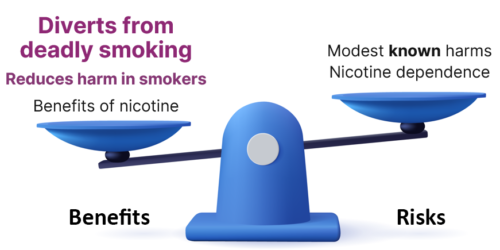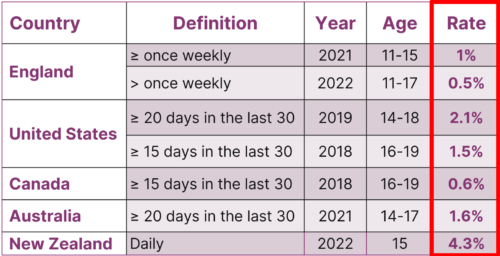
Youth vaping: a risk-benefit analysis
Posted on September 21, 2023 By Colin
THE MEDIA IS AWASH WITH CONCERNS about youth vaping. However a balanced assessment should consider both the harms as well as the benefits. I did a risk-benefit analysis based on the latest evidence and found that the benefits of youth vaping outweighed the risks at a population level.
To be clear, kids should not vape or smoke or drink alcohol or use drugs. However, in the real world, some will do these things. Understanding the full impact is crucial as youth vaping is the main driver of vaping policy. Policy should be based on evidence, not on moral judgements or emotion. Here is the evidence.
The findings were presented at the Global Forum on Tobacco and Nicotine Conference* in Seoul, Korea today [slides and references here].
1. Frequent vaping by never-smokers is rare
The main public health concern about youth vaping is frequent use by young people who have never smoked, as they are exposed to new, potential risks from inhaled chemicals. Frequent vaping is generally defined as vaping more than weekly, or 20 days or more per month.
However, most vaping by never-smokers is experimental and short term. Frequent use is rare, so exposure to chemicals is very low in most cases
According to two recent Australian studies, <2% of never-smoking 14-17 year olds vape nicotine frequently. These findings are similar to those in other western countries:

Frequent vaping rates by never-smokers in western countries
2. Vaping is not a gateway to smoking
Rather than being a gateway to smoking, the evidence suggests that vaping is actually diverting young people away from smoking overall. As vaping rates have increased, the decline in youth smoking rates has accelerated, for example in the US, the UK and New Zealand. This is because vapes and cigarettes are substitutes.
Measures to restrict youth vaping (such as increasing taxes, reducing access and flavour bans) lead to more smoking, which is much more harmful.
Furthermore, those who vape first (before smoking) are less likely to smoke later, compared to those who smoke first.
If vaping is a gateway to smoking for some youth, it is greatly outweighed by a much larger number moving from smoking to vaping
More about the gateway theory here.
3. Nicotine dependence in never-smokers is rare
A small minority of never-smokers who try vaping become nicotine-dependent. One large US study found that <4% of high schoolers who were currently vaping, but had never smoked, had signs of nicotine dependence.
This is to be expected as most never-smokers do not vape frequently enough to become nicotine-dependent, and many do not use nicotine
Nicotine dependence can cause unpleasant symptoms such as temporary anxiety, restlessness and difficulty concentrating when nicotine is ceased. However it is not serious.
4. The harms from youth vaping are small
Most youth vape infrequently, especially those who have never smoked, so there is lower toxicant exposure in most cases.
Laboratory studies exposing cells and animals to aerosols demonstrate some harmful respiratory effects, but there is no evidence in humans of functionally-important respiratory symptoms and no evidence that vaping triggers asthma.

Findings in rodents in laboratory studies often do not transfer to humans
Nicotine may harm the brain in adolescent rodents, but again there is no evidence of harm in humans. Vaping nicotine does not cause EVALI, “popcorn lung”, seizures or pneumothorax. Burns and injuries are very rare.
However, there may be cardiovascular and lung effects in the long-term and we need to be monitor for these, but the absolute harm is likely to be very small.
5. Vaping nicotine provides benefits
Some adults smoke for the beneficial effects of nicotine and young vapers can get similar benefits
It is well established that nicotine provides pleasure, relieves anxiety and depression. In the US National Youth Tobacco Survey in 2021, the most common reason given for vaping was “I am feeling anxious, stressed, or depressed”.
Nicotine also improves concentration, memory and cognitive function and can help with weight control.
Furthermore, nicotine is beneficial for certain medical conditions such as ADHD and schizophrenia.
Risk-benefit analysis
Overall, the benefits of vaping in young people outweigh the risks
Most of the benefit comes from diverting young people away from deadly smoking and from helping current smokers to quit. However vaping nicotine does provide some well recognised benefits of its own.

The known harms from vaping nicotine are modest. Further harms may arise in the future and we need to be vigilant and monitor for these. However, they are highly likely to be small.
This is not to endorse youth vaping. Kids should not smoke or vape
However, unjustified concerns about youth should not drive policy. Evidence based policy should focus more on increasing access for adult smokers, for whom vaping can be lifesaving.
Slides
A risk-benefit analysis of vaping by young people. GTNF 21Sept2023
Disclosure*
I was invited by the GTNF conference organisers to speak at the conference. I paid my own travel costs and did not accept any speaker fee.